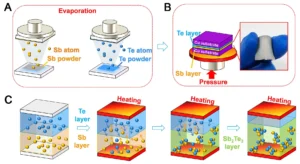Sb2Te3 as a Research Material for ReRAM Devices: An In-Depth Overview
Introduction
The rapid evolution of technology in recent decades has driven the need for faster, more efficient, and reliable memory devices. Among the various types of non-volatile memory, Resistive Random-Access Memory (ReRAM) has gained significant attention due to its promising performance in terms of speed, energy efficiency, scalability, and endurance. ReRAM devices function by switching between different resistive states using an applied voltage, and they are often based on materials that exhibit resistive switching behaviour.
One material that has emerged as a strong candidate for use in ReRAM devices is Antimony Telluride (Sb2Te3). This compound, traditionally known for its applications in thermoelectrics, is now being explored in the realm of resistive switching due to its unique properties. In this blog, we will explore the characteristics of Sb2Te3, its suitability for ReRAM applications, and the potential it holds in next-generation memory technologies.
What is Sb2Te3?
Antimony telluride (Sb2Te3) is a binary semiconductor composed of antimony (Sb) and tellurium (Te) in a 2:3 atomic ratio. It is most commonly known for its thermoelectric properties, particularly in the context of thermoelectric devices like Peltier coolers and thermoelectric generators. Sb2Te3 is a member of the chalcogenide family of materials, which are widely used in phase-change memory (PCM) applications, particularly due to their ability to undergo reversible phase transitions between crystalline and amorphous states.
Crystal Structure and Physical Properties of Sb2Te3
Sb2Te3 typically crystallizes in a rhombohedral structure and exhibits several key physical properties that make it attractive for use in ReRAM:
- Electrical Conductivity: Sb2Te3 exhibits semiconducting behaviour at room temperature. Its electrical properties can be modulated by doping with other elements, making it useful for controlling the resistive switching mechanism in ReRAM devices.
- Thermal Properties: Sb2Te3 has a high thermoelectric figure of merit (ZT), meaning it can efficiently convert heat into electricity. This characteristic is not only useful in thermoelectric devices but also suggests potential advantages in ReRAM devices that require rapid switching speeds.
- Phase Change: Sb2Te3 can undergo a phase change between its crystalline and amorphous states, which is a key feature leveraged in both phase-change memory and ReRAM technologies. This ability to change phases in response to external stimuli is central to its application in memory devices.

Resistive Switching Mechanism in ReRAM
Resistive switching is the phenomenon where a material undergoes a change in resistance when subjected to an external voltage. This change in resistance typically results from the migration of oxygen vacancies or metal filaments within the material. In ReRAM devices, the material used as the switching layer must exhibit high and stable resistance states, which can be toggled by voltage pulses to encode data.
In the case of Sb2Te3, the resistive switching behaviour can be attributed to the migration of native defects (such as vacancies or interstitials) or the formation and dissolution of conductive filaments within the material. The resistance states (high resistance state, or HRS, and low resistance state, or LRS) are retained when no voltage is applied, providing non-volatile memory.
Advantages of Using Sb2Te3 for ReRAM
Several factors make Sb2Te3 an excellent candidate for ReRAM devices:
- Phase-Change Behaviour: Sb2Te3 exhibits reversible phase transitions between a crystalline state (low resistivity) and an amorphous state (high resistivity). This inherent property allows Sb2Te3 to demonstrate robust resistive switching, an essential feature for ReRAM.
- Scalability: Sb2Te3 can be deposited using various techniques such as sputtering, pulsed laser deposition (PLD), and atomic layer deposition (ALD). These deposition methods are scalable, which is essential for commercial manufacturing of ReRAM devices.
- Low Power Consumption: Compared to other memory technologies, ReRAM devices based on Sb2Te3 can operate at lower power levels. This is due to the relatively low voltage required for the resistive switching process, which is a critical factor for energy-efficient memory technologies.
- Fast Switching Speed: Sb2Te3-based ReRAM devices have demonstrated fast switching speeds in the range of nanoseconds, making them suitable for high-performance applications in computing and data storage.
- Endurance and Retention: Sb2Te3-based ReRAM devices have shown good cycling endurance, meaning they can withstand numerous switching cycles without significant degradation in performance. Additionally, the material has good data retention characteristics, which is crucial for non-volatile memory applications.
Challenges and Research Opportunities
Despite the promising properties of Sb2Te3, there are several challenges that researchers are actively working to address:
1. Uniformity of Resistive Switching: One of the main challenges in ReRAM devices is achieving uniform resistive switching across a large array of devices. Sb2Te3-based ReRAM devices may exhibit variability in their switching behaviour, which can be problematic for large-scale integration. Research is focused on understanding and controlling the microstructure of Sb2Te3 to ensure uniform switching characteristics.
2. Optimizing Doping and Composition: The resistive switching performance of Sb2Te3 can be significantly affected by doping with other elements or adjusting the stoichiometry of the material. Researchers are exploring different doping strategies and alloying Sb2Te3 with other chalcogenides to optimize its electrical and switching properties.
3. Cycling Stability: While Sb2Te3-based ReRAM devices show good endurance, further research is needed to enhance the cycling stability and reduce the wear-out effects that can degrade device performance over time.
4. Mechanism of Switching: Although Sb2Te3 exhibits resistive switching, the precise mechanism of switching (e.g., vacancy migration, metal filament formation) is still not fully understood. Understanding the switching mechanism at the atomic level will be crucial for improving the efficiency and reliability of ReRAM devices based on Sb2Te3.
5. Integration with Existing Technologies: The integration of Sb2Te3-based ReRAM devices into existing semiconductor processes remains a challenge. Researchers are working on developing compatible deposition techniques and architectures that will allow for the integration of Sb2Te3 into current memory systems.
Future Outlook
The potential of Sb2Te3 as a material for ReRAM devices is immense. With continued advancements in material processing, doping techniques, and device architecture, Sb2Te3-based ReRAM devices could play a key role in the future of non-volatile memory. Given the increasing demand for high-performance, low-power, and scalable memory solutions, ReRAM based on Sb2Te3 may find widespread applications in fields such as:
- Next-generation data storage: Sb2Te3-based ReRAM devices offer high storage density and fast access times, making them suitable for high-capacity storage systems.
- Neuromorphic computing: The ability of Sb2Te3-based ReRAM devices to mimic synaptic behaviour makes them a strong candidate for neuromorphic computing systems, which are designed to replicate brain-like processing.
- Edge computing and IoT: The low power consumption and fast switching characteristics of Sb2Te3 make it ideal for memory in resource-constrained devices like edge computing nodes and IoT devices.
Conclusion
Sb2Te3 presents a fascinating material for the development of ReRAM devices. Its phase-change properties, electrical conductivity, and scalability make it an attractive candidate for next-generation non-volatile memory technologies. Although challenges remain, ongoing research into the material’s properties and performance in ReRAM applications promises to unlock new possibilities for high-speed, low-power memory systems. As the demand for more efficient memory devices grows, Sb2Te3-based ReRAM could provide the foundation for future breakthroughs in memory and computing technologies.
By continuing to investigate and optimize this material, researchers may be able to address the current challenges and realize the full potential of Sb2Te3 in ReRAM devices, driving the evolution of non-volatile memory systems in the years to come.




